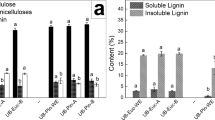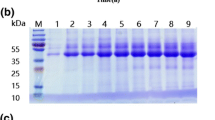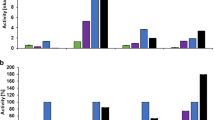Abstract
Roles played by fiber physical and chemical characteristics in enzymatic hydrolysis of cellulosic materials were investigated by analyzing the interaction between an endoglucanase complex and eucalypt kraft fibers. PFI refining was employed to create the difference of fiber size distribution and morphology. Oxygen delignification and bleaching were employed to prepare fibers with different lignin and pentosan contents. The enzyme accessibility was monitored by adsorption at 4 °C and during hydrolysis at 40 °C. Molecular weight changes and reducing sugar released were monitored for digestibility of the samples. Greater maximum adsorption capacities of the enzymes were shown for the pulps with shorter and wider fibers and more fine fractions after refining. Highest amount of enzyme was adsorbed onto fibers with the least lignin contents at 4 °C. Fewer desorbed from fibers with higher lignin contents during hydrolysis at 40 °C. For unrefined fibers, less molecular weight reductions were observed for fibers with higher lignin contents. However, extensive fibrillation by refining negated the effects of lignin on the action of endoglucanase, similar molecular weight reductions were observed for fibers with three different lignin contents. Refining could be able to expose more reaction sites on the fiber surface, hence the impacts of lignin and pentosan diminished during hydrolysis for refined fibers.






Similar content being viewed by others
References
Bennett AE, Rienstra CM, Auger M, Lakshmi KV, Griffin RG (1995) Heteronuclear decoupling in rotating solids. J Chem Phys 103:6951–6958
Bhardwaj NK, Duong TD, Nguyen KL (2004a) Pulp charge determination by different methods: effect of beating/refining. Colloids Surf 236:39–44
Bhardwaj NK, Kumar S, Bajpai PK (2004b) Effects of processing on zeta potential and cationic demand of kraft pulps. Colloid Surf 246:121–125
Bhat MK (2000) Cellulases and related enzymes in biotechnology. Biotechnol Adv 18:355–383
Boussaid A, Saddler JN (1999) Adsorption and activity profiles of cellulases during the hydrolysis of two Douglas fir pulps. Enzyme Microb Technol 24:138–143
Chernoglazov VM, Ermolova OV, Klyosov AA (1988) Adsorption of high-purity endo-1, 4-beta-glucanases from Trichoderma reesei on components of lignocellulosic materials: cellulose, lignin, and xylan. Enzyme Microb Technol 10:503–507
Fan LT, Lee YH, Beardmore DH (1980) Mechanism of the enzymatic hydrolysis of cellulose: effects of major structural features of cellulose on enzymatic hydrolysis. Biotechnol Bioeng 22:177–199
Fengel D, Wegener G (1983) Wood chemistry, ultrastructure, reactions. Walter de Gruyter, Berlin
Gilkes NJ, Henrissat B, Kilburn DG, Miller RC, Warren RAJ (1991) Domains in microbial β-1, 4-glycanases: sequence conservation, function, and enzyme families. Microbiol Rev 55:303–315
Goulet MT, Stratton RA (1990) The effect of pul**, bleaching, and refining operations on the electrokinetic properties of wood fines. Nordic Pulp Pap Res J 3:118–125
Hartmann SR, Hahn EL (1962) Nuclear double resonance in the rotating frame. Phys Rev 128:2042–2053
Himmel ME, Ding SY, Johnson DK, Adney WS, Nimlos MR, Brady JW, Foust TD (2007) Biomass recalcitrance: engineering plants and enzymes for biofuels production. Science 315:804–807
Hrmova M, Harvey AJ, Wang J, Shirley NJ, Jones GP, Stone BA, Høj PB, Fincher GB (1996) Barley beta-D-glucan exohydrolases with beta-D-glucosidase activity. Purification, characterization, and determination of primary structure from a cDNA clone. J Biol Chem 271(9):5277–5286
Huang HJ, Ramaswamy S, Al-Dajania WW, Tschirner U (2010) Process modeling and analysis of pulp mill-based integrated biorefinery with hemicellulose pre-extraction for ethanol production: A comparative study. Bioresour Technol 101(2):624–631
Ishizawa CI, Jeoh T, Adney WS, Himmel ME, Johnson DK, Davis MF (2009) Can delignification decrease cellulose digestibility in acid pretreated corn stover? Cellulose 16:677–686
Jeoh T, Ishizawa CI, Davis MF, Himmel ME, Adney WS, Johnson DK (2007) Cellulase digestibility of pretreated biomass is limited by cellulose accessibility. Biotechnol Bioeng 98:112–122
Kautto J, Henricson K, Sixta H, Trogen M, Alen R (2010) Effects of integrating a bioethanol production process to a kraft pulp mill. Nordic Pulp Pap Res J 25(2):233–242
Kerkes RJ (2005) Characterizing refining action in PFI mills. Tappi J 4(3):9–13
Ko CH, Lin ZP, Tu J, Tsai CH, Liu CC, Chen HT, Wang TP (2010) Xylanase production by Paenibacillus campinasensis BL11 and its pretreatment of hardwood kraft pulp bleaching. Int Biodeterior Biodegrad 64:13–19
König J, Grasser R, Pikor H, Vogel K (2002) Determination of xylanase, beta-glucanase, and cellulase activity. Anal Bioanal Chem 374:80–87
Kumar R, Wyman CE (2009) Cellulase adsorption and relationship to features of corn stover solids produced by leading pretreatments. Biotechnol Bioeng 103:252–267
Linder M, Teeri T (1997) The roles and function of cellulose-binding domains. J Biotechnol 57:15–28
Lynd LR, Weimer PJ, van Zyl WH, Pretorius IS (2002) Microbial cellulose utilization: fundamentals and biotechnology. Microbiol Mol Biol Rev 66:506–577
Lynd LR, Laser MS, Brandsby D, Dale BE, Davison B, Hamilton R, Himmel M, Keller M, McMillan JD, Sheehan J, Wyman CE (2008) How biotech can transform biofuels. Nat Biotechnol 26:169–172
Lyytikäinen K, Saukkonen E, Kajanto I, Käyhkö J (2011) The effect of hemicellulose extraction on fiber charge properties and retention behavior of kraft pulp fibers. BioResources 6:219–231
Mao HB, Genco JM, van Heiningen A, Pendse H (2010) Kraft mill biorefinery to produce acetic acid and ethanol: technical economic analysis. BioResources 5(2):525–544
Nidetzky B, Steiner W, Claeyssens M (1994) Cellulose hydrolysis by the cellulases from Trichoderma reesei: adsorptions of two cellobiohydrolases, two endocellulases and their core proteins on filter paper and their relation to hydrolysis. Biochem J 303(3):817–823
Ooshima H, Burns DS, Converse AO (1990) Adsorption of cellulase from Trichoderma reesei on cellulose and lignacious residue in wood pretreated by dilute sulfuric-acid with explosive decompression. Biotechnol Bioeng 36:446–452
Palonen H, Tjerneld F, Zacchi G, Tenkanen M (2004) Adsorption of Trichoderma reesei CBH I and EG II and their catalytic domains on steam pretreated softwood and isolated lignin. J Biotechnol 107:65–72
Piccolo C, Wiman M, Bezzo F, Liden G (2010) Enzyme adsorption on SO2 catalyzed steam-pretreated wheat and spruce material. Enzyme Microb Technol 46:159–169
Ramos LP, Nazhad MM, Saddler JN (1993) Effect of enzymatic hydrolysis on the morphology and fine structure of pretreated cellulosic residues. Enzyme Microb Technol 15:821–831
Thygesen A, Oddershede J, Lilholt H, Thomsen AB, Stahl K (2005) On the determination of crystallinity and cellulose content in plant fibres. Cellulose 12:563–576
Tu M, Pan X, Saddler JN (2009) Adsorption of cellulase on cellulolytic enzyme lignin from lodgepole pine. J Agric Food Chem 57(17):7771–7778
Uçar G, Balaban M (2004) Accurate determination of the limiting viscosity number of pulps. Wood Sci Technol 38:139–148
Zhang YHP, Himmel ME, Mielenz JR (2006) Outlook for cellulase improvement: screening and selection strategies. Biotechnol Adv 24:452–481
Zhu JY, Wang GS, Pan XJ, Gleisner R (2009) Specific surface to evaluate the efficiencies of milling and pretreatment of wood for enzymatic saccharification. Chem Eng Sci 64:474–485
Acknowledgments
The authors thank partial financial supports from National Science Council, Taiwan, ROC for this study under project no. 99-3113-P-301-001.
Author information
Authors and Affiliations
Corresponding author
Rights and permissions
About this article
Cite this article
Ko, CH., Chen, FJ., Lee, J.J. et al. Effects of fiber physical and chemical characteristics on the interaction between endoglucanase and eucalypt fibers. Cellulose 18, 1043–1054 (2011). https://doi.org/10.1007/s10570-011-9534-y
Received:
Accepted:
Published:
Issue Date:
DOI: https://doi.org/10.1007/s10570-011-9534-y




